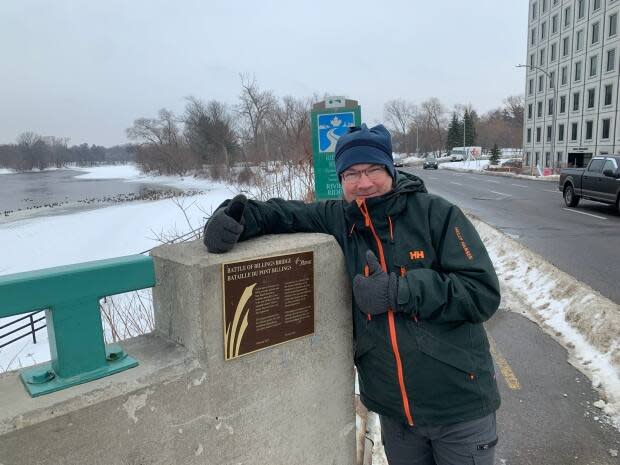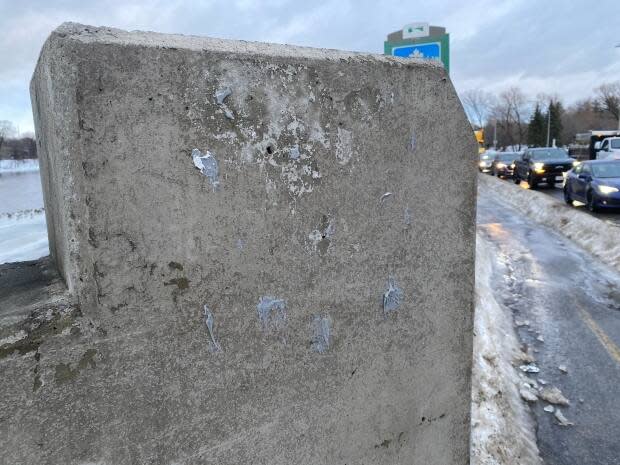Fake plaque marking 'Battle of Billings Bridge' vanishes

A bronze plaque commemorating the February 2022 convoy counter-blockade that came to be known as the Battle of Billings Bridge has vanished, just hours after it was first noticed glued to a concrete wall at the corner of Riverside Drive and Bank Street.
At first glance, the plaque, which appeared Thursday, bore all the hallmarks of an official historical marker, including the City of Ottawa logo.
But the city told CBC on Friday that it neither installed the plaque nor removed it overnight, adding to the mystery.
The marker read, "At this spot on February 13, 2022, everyday citizens and Ram Ranch Resistance members peacefully stood in the way of those who had trampled citizens' right to peace, free movement and free expression."
"This plaque commemorates the ordinary people who did something extraordinary when their leaders would not."

Many anti-convoy protesters began calling themselves the Ram Ranch Resistance after fellow counter-protesters popularized the song Ram Ranch — a raunchy song about gay cowboys — to disrupt online conversations between convoy supporters.
Sean Burges, a professor at Carleton University, said the appearance of the plaque was a pleasant surprise — much like the number of people who gathered at the bridge after he made a Facebook post calling for community members to join him to prevent convoy protesters from getting downtown.
"It was regular moms and dads, and grandpas and grandmas … coming out and just saying 'Enough. Protest all you want, but you've overtaken the city and you're abusing people. It's time to stop,'" he said.
Burges said the counter-protest began with just 15 people at about 9:00 a.m., growing to a crowd of hundreds over the course of nine hours.
The day that 'turned the tide'
Burges remembered the crowd chanted "Whose streets? Our streets!" as they blocked a growing line of cars and trucks from getting onto the bridge.
"There was no planning for this, no clear agenda other than just to voice 'Go home'," he said.
Robert Ramsay, who lives in Old Ottawa South, was also at the so-called battle. He said community members like himself were forced to take matters into their own hands during the third weekend of the anti-pandemic rule and anti-government protest.
"We really did feel like we had been abandoned by city leadership, by the police, by multiple levels of government," he said.

That's why Ottawa resident Andrea Harden said she stood at the front lines of the counter-protest. At one point, she said, a truck tried to come through the crowd "rolling very slowly."
"I put my back against the truck … and said 'No, you stop here and we're not allowing you to go downtown'," she recalled.
"That was kind of the start of it, this moment."
What followed was an "intense" standoff between convoy participants and counter-protesters, but Harden said the latter party was successful in the end.
"We turned every single one of those trucks around and made it very clear that they should not be going … to join the convoy," she said.
"It really was the moment that turned the tide on this occupation."
Plaque remains a mystery
The City of Ottawa told CBC News in an emailed statement Thursday that it was "reviewing the matter," but did not say whether it would take down the plaque. By Friday morning, it was gone, and the city said it wasn't responsible.
Harden, Ramsay and Burges said Thursday they'd like to see it stay — although who installed it remains a mystery.

Burges said he's "vaguely embarrassed" he was not the person behind the plaque, but thought it was "wonderful," should stay and did a better job than most plaques of marking history.
"The fact that somebody has independently decided to craft a plaque that sends the message that this neighbourhood values freedom of expression, it values freedom of assembly, it values freedom of movement … is a very powerful statement," he said.
"For most of us, it's really significant."


